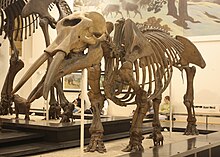| Gomphothere Temporal range: Late Oligocene - Holocene
| |
|---|---|

| |
| Specimen of Gomphotherium productum at the American Museum of Natural History | |

| |
| Notiomastodon platensis Centro Cultural del Bicentenario de Santiago del Estero in Argentina | |
| Scientific classification | |
| Domain: | Eukaryota |
| Kingdom: | Animalia |
| Phylum: | Chordata |
| Class: | Mammalia |
| Order: | Proboscidea |
| Superfamily: | †Gomphotherioidea |
| Family: | †Gomphotheriidae (Hay, 1922) A. Cabrera 1929 |
| Genera | |
| |
Gomphotheres are an extinct group of proboscideans related to modern elephants. First appearing in Africa during the Oligocene, they dispersed into Eurasia and North America during the Miocene and arrived in South America during the Pleistocene as part of the Great American Interchange. Gomphotheres are a paraphyletic group ancestral to Elephantidae, which contains modern elephants, as well as Stegodontidae.
While most famous forms such as Gomphotherium had long lower jaws with tusks, the ancestral condition for the group, some later members developed shortened (brevirostrine) lower jaws with either vestigial or no lower tusks and outlasted the long-jawed gomphotheres. This change made them look very similar to modern elephants, an example of parallel evolution. During the Pliocene and Early Pleistocene, the diversity of gomphotheres declined, ultimately becoming extinct outside of the Americas. The last two genera, Cuvieronius ranging southern North America to western South America, and Notiomastodon ranging over most of South America, continued to exist until the end of the Pleistocene around 12,000 years ago, when they became extinct along with many other megafauna species following the arrival of humans.
The name "gomphothere" comes from Ancient Greek γόμφος (gómphos), "peg, pin; wedge; joint" plus θηρίον (theríon), "beast".